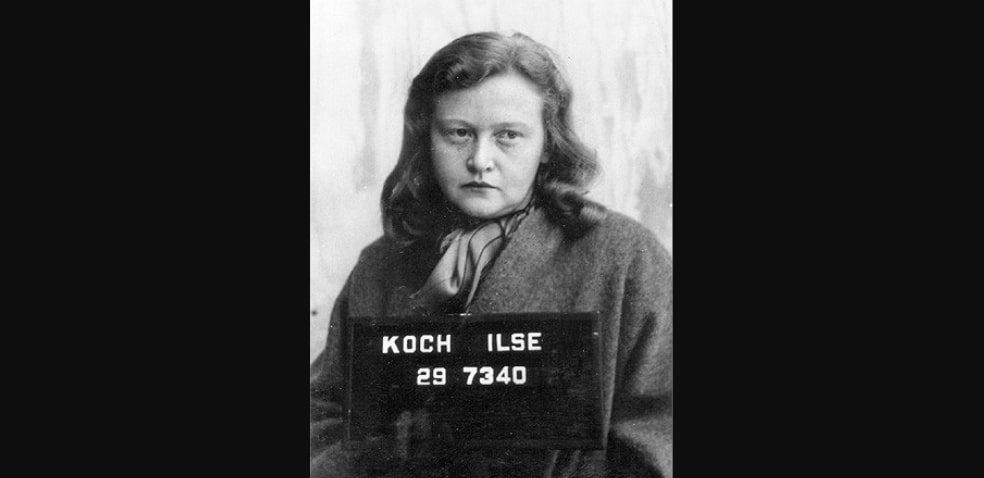In Netflix’s ‘Monster: The Ed Gein Story,’ the character of Ilse Koch is fantastically referenced. Koch, the wife of a Nazi officer from Germany, becomes known to Gein through books and stories about her horrific crimes and is introduced to him by a friend. Gein develops a morbid fascination with her, drawn to her notoriety as the “Beast of Buchenwald.” Fascinated by the stories about her alleged crimes, he begins experimenting with human remains and eventually starts creating a mask from human skin for himself.
Ilse Koch’s Alleged Human Skin Lamps Propelled Her Image as a Notorious Criminal
In the series, when Ed Gein discovers comic books detailing the horrific crimes of Ilse Koch, he becomes mesmerized. He explains that, for him, it is the human action itself that matters, and knowing such acts have been committed before seems to set a precedent, making him feel justified in the crimes he later commits. In reality, Ilse Koch was the wife of Karl-Otto Koch, the commandant of the Buchenwald concentration camp. She was born on September 22, 1906, in Dresden, Germany, and joined the Nazi Party in 1932. In 1937, she married Koch while he was stationed at Sachsenhausen and later moved with him to Buchenwald.

Ilse had three children, a son and two daughters, while living at Buchenwald. She was first arrested in 1943 on charges of habitually receiving stolen goods, having allegedly taken at least 25,000 RM for her own benefit. She was acquitted in December 1944, while her husband was found guilty of various corruption offenses and sentenced to death. Afterward, Ilse lived in a small apartment in Ludwigsburg with her children until June 30, 1945, when a former Buchenwald prisoner recognized her on the street and reported her to US authorities. She was accused of committing war crimes, though the exact charges were never formally specified, and rumors about her actions had already begun circulating widely.
It was widely alleged that Ilse tortured prisoners at Buchenwald and had a fascination with human skin, with rumors alleging that she created lampshades and collected tattoos from the corpses of inmates. These stories, though sensationalized, became part of the lore surrounding her. While various objects fashioned from human skin were discovered in Buchenwald’s pathology department at the camp’s liberation, none were conclusively linked to Ilse herself. Despite the lack of direct evidence, the allegations spread rapidly, capturing public imagination and later influencing popular culture through comic books, sensationalist articles, and editorials. Ultimately, she was found guilty of committing war crimes in August 1947 by an American military court at Dachau.
Related
Ilse Koch Was Given Nicknames Due to the Rumors and Allegations Surrounding Her Actions
In 1948, Ilse Koch’s conviction was reviewed and reassessed. During this process, it was determined that many of the alleged atrocities had been exaggerated in the media, and there was no evidence to prove that she had committed such crimes. While there was evidence that she had physically struck a few inmates, none of these actions had resulted in deaths, leading the court to conclude that her offenses had been overstated. In June 1948, her sentence was reduced from life imprisonment to four years, a decision that sparked widespread protests, particularly in the US, from both political organizations and the media. She was rearrested in 1949 and tried under the West German judiciary. During the trial, she maintained that she had been occupied with raising her children and had neither witnessed nor participated in any inhumane acts while at the camp.

During the trial, at least four prosecution witnesses alleged to have observed Koch selecting tattooed prisoners who were later executed, or being involved in the alleged creation of lampshades from human skin. However, the prosecution eventually dropped this particular allegation, as they could not provide conclusive evidence that any such items had actually been produced. In January 1951, Koch was convicted on multiple charges, including seven counts of incitement to grievous bodily harm, one count of incitement to attempted murder, and one count of incitement to murder. She was sentenced to life imprisonment along with the permanent loss of her civil rights. By this time, her mental health had noticeably deteriorated, and she reportedly began experiencing delusions, imagining that former prisoners were appearing to her in her jail cell.
Ilse hanged herself in her prison cell on September 1, 1967, and became known as one of the most infamous figures of the Nazi era. Over the decades, stories and legends about her cruelty have been widely circulated and have often been used as examples of extreme human depravity. She has been given several nicknames like “The Beast of Buchenwald,” the “Red Witch of Buchenwald,” “Butcher Widow,” and “The Bitch of Buchenwald.” Several factors contributed to her notoriety, including her strikingly domineering personality and the way her actions were framed through the lens of gender. Many court documents and accounts emphasized that her alleged crimes were “beyond what was expected of a woman,” amplifying perceptions of her as uniquely monstrous. Media portrayals over the years further reinforced this image and have turned her into a symbol of both personal and systemic cruelty.




You must be logged in to post a comment.